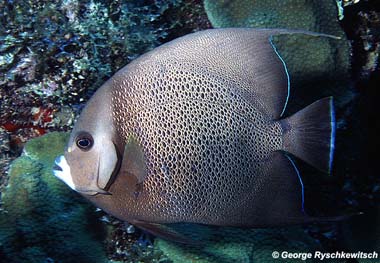
Pomacanthus arcuatus
These flat, oval fish have trailing dorsal and anal fins, sometimes as long as their squared tail fin. They are gray to brown, with dark spots on each scale, and white mouths. Juveniles are almost black, with five yellow bands on each side, but they change to a uniform gray, and their rounded fins become more angular over time. These reef fish have been observed forming long-term monogamous breeding pairs. Because they are curious and brave, they are popular with reef divers and photographers, as well as being fished for food.
Order – Perciformes
Family – Pomacanthidae
Genus – Pomacanthus
Species – arcuatus
Common Names
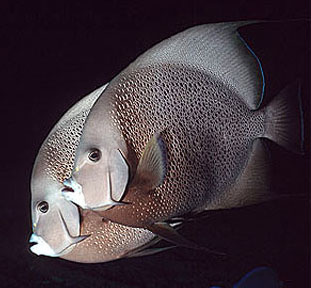
English language common names include angelfish, gray angelfish, and pot cover. Other common names are cachama blanca (Spanish), chivirica gris (Spanish), demoiselle blanche (French), enxada (Portuguese), frade (Portuguese), guinea (Spanish), nezumi-yakko (Japanese), paru-bordado (Portuguese), paru-da-pedra (Portuguese), paru-dourado (Portuguese), paru-frade (Portuguese), paru-listrado (Portuguese), and ustniczek francuzik (Polish).
Importance to Humans
Possessing flesh of excellent quality, the gray angelfish is marketed either fresh or salted. There have been reports of ciguatera poisoning associated with human consumption of this fish.
These fish appear to divers as curious and brave. For this reason, they are a popular subject for underwater photographers.
Conservation
> Check the status of the gray angelfish at the IUCN website.
The IUCN is a global union of states, governmental agencies, and non-governmental organizations in a partnership that assesses the conservation status of species.
Geographical Distribution
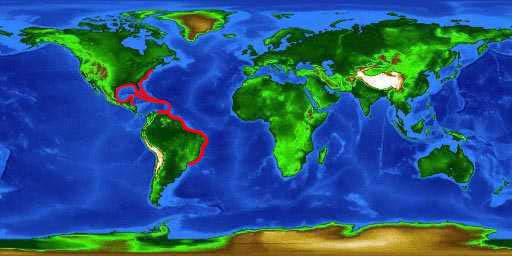
The gray angelfish, easily confused with the French angelfish (Pomacanthus paru), is common among the coral reefs in the western Atlantic Ocean. Both the gray angelfish and the French angelfish range from New England (U.S.) south to Rio de Janeiro (Brazil) including the West Indies and occasionally the Gulf of Mexico. Both species have been recently introduced to Bermuda.
Habitat
Usually observed in pairs, the gray angelfish swims among coral reefs at depths ranging from 7-98 feet (2-30 m). Reef habitats provide plenty of cover for the angelfish to hide from predators during night time hours. Juveniles inhabit shallow patch reefs and grassy areas.
Biology
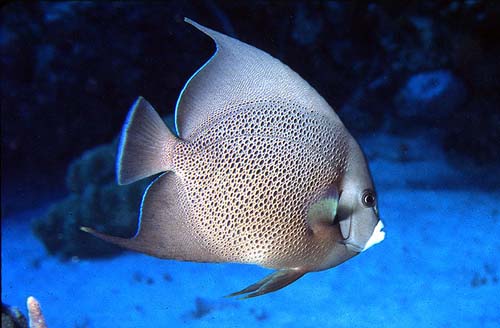
Distinctive Features
The gray angelfish has a thin, discus-shaped body with a small mouth. The lower jaw protrudes past the upper jaw. The mouth is small and contains comb-like teeth. All vertical fins are scaled and the dorsal fin is continuous, helping to distinguish it from the closely related spadefish which has two separate dorsal fins. The anal and dorsal fins both have filaments that may stretch past the end of the caudal fin. The pectoral fin extends past the base of the anal fin. The caudal fin is rounded in juveniles while the adults have a nearly straight edge.
Coloration
Juvenile gray angelfish are black with five yellow bands on the head and body, extending onto the fins. The yellow band on the head of the juvenile gray angelfish runs through the mouth to the chin with a yellow ring around the lips, distinguishing it from the French angelfish (Pomacanthus paru). Also, the juvenile French angelfish has a round black spot on the caudal fin while the gray angelfish has an irregular black blotch. The juvenile gray angelfish has a square tail terminating in a white or transparent margin.
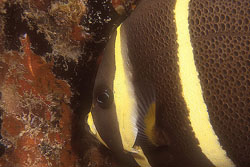
As the juvenile grows into an adult, it loses its yellow bands and becomes a uniform gray to grayish-brown in color. Scales develop a large gray or brown spot in the center and are edged in pale gray. The head, chest, pelvic, and pectoral fins become dark brown while the chin and mouth region turn white. The fins are dark brown, becoming darker along the edges with the exception of the dark caudal fin that has a white or pale gray margin. The pectoral fins of the gray angelfish have a yellow inner face while the French angelfish has a yellow blotch on the outer bases.
Size, Age, and Growth
The gray angelfish attains a maximum length of 24 inches (60cm) and weight of 4 pounds (1.8 kg). However, these fish are more commonly observed at lengths of 17-19 inches (43-48 cm). The average body depth of the adult is 1.3-1.4 inches (3.3-3.5 cm). Maturity is attained at 9 inches (23 cm) in length.
Food Habits
Primarily feeding on sponges, this omnivore also eats a wide range of algae and invertebrates including tunicates, zoantharians, gorgonians, hydroids, and bryozoans. The juveniles feed on algae and detritus along with ectoparasites they clean from other fish. They tend “cleaning stations” where they remove these ectoparasites from a wide range of fishes including jacks, snappers, morays, grunts, surgeonfishes, and wrasses.
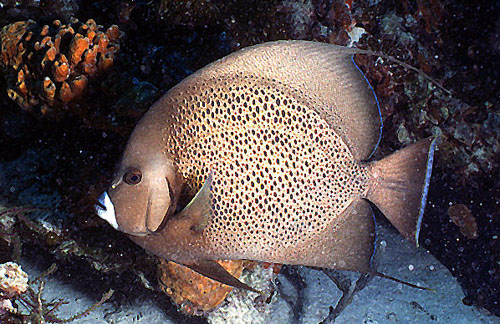
Reproduction
Spawning occurs from April through September. Angelfish have been observed spawning over deep reef areas in the early morning hours. Pairs of these fish cruise several feet above the reef with a few short chases. If solitary individuals approach the pair too closely, they are quickly chased away. The pair swims slowly, rising in the water column, bringing their vents close together and releasing eggs and sperm into the water. During each spawning event, 25,000-75,000 eggs are released. The fish separate and return to the bottom, repeating this activity numerous times. The pelagic eggs are spherical and transparent with a diameter of 0.9mm. Larval angelfish hatch approximately 15-20 hours after fertilization. The larvae live in beds of floating plankton until they reach approximately 15mm when they settle onto the coral reef. The juveniles are dark-colored with pigmented vertical bars.
Parasites
Unidentified crab zoeae have been reported to infest the gills of a gray angelfish held in a trap.
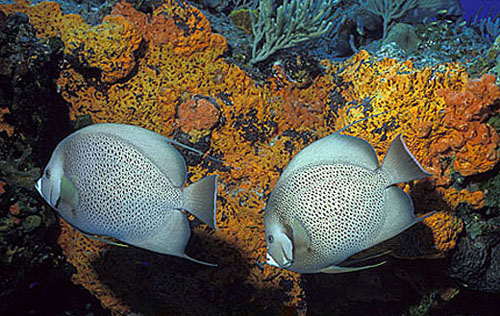
Predators
Large fishes are potential predators of the gray angelfish. Larvae and juveniles may be prey for invertebrate predators as well.
Taxonomy
Carl Linnaeus described the gray angelfish as Pomacanthus arcuatus in 1758. Synonyms of P. arcuatus include Chaetodon aureus Bloch 1787, Chaetodon lutescens Bonnaterre 1788, Pomacanthus baltcatus Cuvier 1831, Pomacanthus cingulatus Cuvier 1831, Pomacanthus cinquecinctus Cuvier 1831, and Chaetodon littoricola Poey 1868.
Prepared by: Cathleen Bester